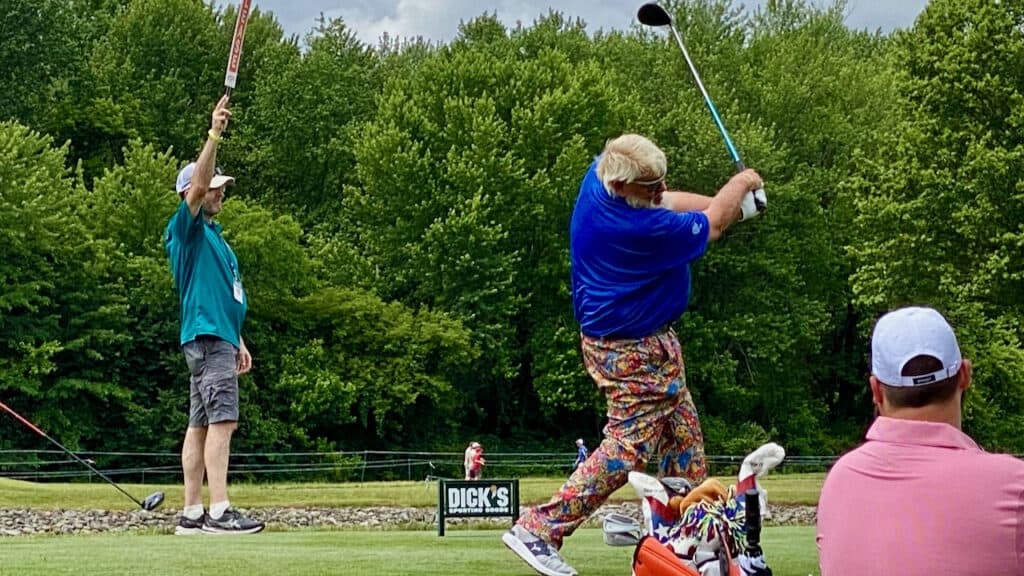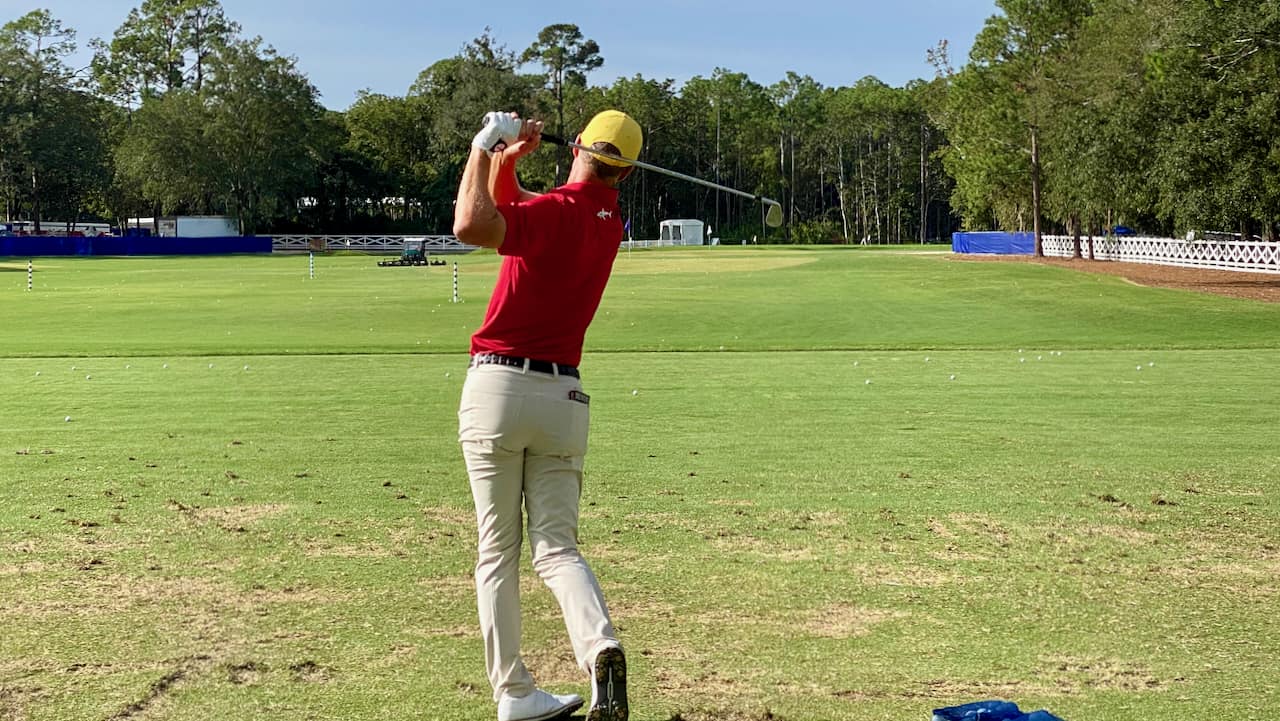Table of Contents
How to get more power in your golf swing? In this article, our golf expert provides golf tips for seniors when losing distance in golf.
Accepting to play from the forward tees is a difficult choice for some older adults, however, a large population of retirees embrace this advantage. Some might even say it’s a golfer’s “rite of passage” to move to the forward tees. One major advantage to moving up a set of tees is the overall course length decreases, allowing approach shots to be hit with irons instead of woods.
What do senior golfers do if they’re still hitting fairway woods into short par 4’s? If you’re struggling with distance off the tee, then your long approach shot hasn’t been resolved. Losing distance in golf over the years is inevitable for those that push physical fitness to the side and simply expect it.
Power and distance are developed through purposeful efforts in swing mechanics and conditioning the body. If you have moved to the forward tees and the course is still too long for you then it’s time to access your dormant physical abilities.
Has your shoulder range decreased as an older adult? Do you rotate less through impact? Is your balance not what it used to be?
If so, here are some proven best practices on how to get more power in a golf swing. Remember, to always consult your physician to determine what modifications are best for your health status.
- Increase your cardiovascular activity with swimming, jogging or walking.
- Engage in lower body exercises like lunges and squats.
- Use resistance bands to put your muscles under tension.
- See if your primary physician can refer you to a physical therapist.
- Maintain a healthy diet as prescribed by your doctor or dietitian
⛳️ Related: Top Golf Exercises for Seniors to Elevate Their Game

3 Drills on How to Get More Power in Your Golf Swing

1. Golf Stance & Range of Motion Drill
Over the past 15+ years, I have worked with hundreds of senior golfers to improve their physical on-course abilities. One of the most common long-term fixes for the typical golden ager is adjusting their golf stance. It is common for older players to undergo hip or knee surgeries/injuries; manipulating the position or angle of your feet can play a significant role in the mobility of your body.
For example, if your range of motion is limited when you take your backswing or follow through, try turning your toes outwards from the center. Doing this will open your hip flexors which will increase your ability to rotate to the right and left. The alignment of your feet can also help you stop from hooking and slicing the ball. Here is a video that goes into detail on foot position and how it relates to your range of motion for your golf swing.
Items required for the golf stance drill:
- Alignment stick
- 8 or 7 iron
- Full or half-length mirror
Given this education behind the stance, I would like you to fully understand the principal concept of balance. Unfortunately, balance is one of the first things to deteriorate as we gracefully age. If balance is off, then your tempo and weight transfer will fall next in-line.
Try standing on one leg with your eyes closed and see how long it takes you to put your foot back down. Chances are you will not make it exceptionally long before you feel off balance.
Here are some numbers to help you set expectations and a link to a scientific study on balance and proprioception.
Healthy Young Adults (Ages 20-39) | Seconds | Average Seconds |
|---|---|---|
| Men | 19.3 to 34.8 | 21 seconds |
| Women | 14.2 to 26.8 | 17 seconds |
Healthy Young Adults (Ages 40-59) | Seconds | Average Seconds |
|---|---|---|
| Men | 11.5 to 26.9 | 18.3 seconds |
| Women | 9.7 to 23.3 | 15.2 seconds |
Healthy Older Adults (Ages 60-80) | Seconds | Average Seconds |
|---|---|---|
| Men | 6.4 to 13.4 | 9.4 seconds |
| Women | 4.6 to 10.2 | 7.4 seconds |
⛳️ Related: Golf Stance Tips to Eliminate an Over the Top Swing

2. Swing Arc Drill

The second most common factor that limits power for senior golfers is width of arc. As the years pass by, most athletes experience a reduction in shoulder rotation if proper stretching is not implicated. Limited shoulder mobility can also greatly affect your ability to swing on plane.
By way of illustration, if your external shoulder rotation is reduced in your trail arm then it’s going to be difficult to raise and lower the club in the proper position at the top of your back swing to impact. Likewise, if the lead arm has limitations in shoulder range, then the follow through could be cut short; reducing your club head speed.
It’s recommended to implement a routine of internal and external stretching of the shoulders so it may increase your swing arc. As a result, this will allow you more time to develop club head speed and power through impact. Here is a short video with a few pro tips for internal/external shoulder rotation.
Items required for the swing arc drill:
- Elastic exercise band
- Tennis ball
- Soccer ball
Now I would like to share a success story with you on one of my older adult students. To say his shoulders had limitations of mobility was the understatement of the year. In fact, his backswing and follow through resembled the range of motion one would use for a long p10 Best Drivers for Slicers to Hit Straighter [Expert Guide]utt. He was obviously frustrated with his overall distance. His drives rarely exceeded 110 yards and most of his irons went the same distance.
Knowing that he lacked mobility, I suggested that he pay a visit to his physical therapist. I sat with him and wrote down a list of physical goals so the doctor could set expectations. Once he was under a plan of care with his physical therapist, he reported back to me for follow up lessons.
As I monitored his mobility, I was able to record considerable progress by week 4. His backswing tripled in length and his follow through was complete. This change put him around the 200 to 215 yards in driving distance. He also noticed that his irons traveled different distances.

3. Lag Drill

The third most common factor for older golfers to lose distance with fairway woods and driver is less lag in the golf swing. Lag is the angle that is created between your lead arm and the golf club shaft. If the angle is narrow, then power has a greater potential to be released at the correct time. However, if lag is not established then power is released prior to impact causing a major loss of club head speed.
Fortunately, lag is easy to fix for most golfers because increasing the wrist hinge at the top of the backswing does not require a lot of effort. The key is to maintain lag as your down swing transition takes place. In most swings, the position and path of the trailing arm will affect your ability to maintain lag to the point of impact. Here is a quick video that I demonstrate the most common golf swing mistakes and how to resolve lag issues.
Items required for the lag drill:
- 6 iron
- Mirror or phone camera
- Elastic exercise band
If you were to study most of the long hitters on the PGA Tour Champions, you will notice that the trail elbow maintains flexion in the downswing. Take Padraig Harrington for example, in 2022, his average driving distance was 308.7 yards. Not too bad for If we pause his swing just prior to impact, you will notice that his right elbow maintains flexion until the ball has been struck.
Consider the bend in the elbow if you were to draw back your right or left hand to throw a ball or a punch. The elbow should remain flexed until you land your target. If you are looking to add power to your golf swing, this same principle applies.
Golf Equipment Review

Getting a club fitting for the proper shaft, loft and length of club is frequently overlooked by an alarming number of golfers. I cannot recall the number of times that I have worked with students that are using the wrong type of equipment.
Whether it’s a shaft that is too heavy or not flexible enough, players tend to neglect the importance of golf club design. Without getting too involved, here are some basics behind golf club design and how it can affect your ball flight.
Shaft Flex:
| Golf Shaft | Swing Speed |
|---|---|
| X-Stiff Shaft | 105mph+ |
| Stiff Shaft | 97mph-104mph |
| Regular Shaft | 84mph-96mph |
| Senior Shaft | 72mph-83mph |
| Lite Shaft | Swing speeds 71 mph & under |
Shaft Weight:
- If you have a quick tempo, it’s recommended to use a heavier shaft to help maintain control.
- Smooth tempo, it’s recommended to use a mid-weight shaft.
- Slow tempo, it’s recommended to use a lite shaft to help acceleration through impact.
Loft:
- Slower swing speeds pair well with high lofted (12-14 degrees) driver and fairway wood heads.
- Faster swing speeds will be most effective with driver lofts of 9.5 to 10.5 degrees.
I highly encourage you to get your swing speed evaluated at your local fitting studio or teaching professional. This could be the long-term solution you have been searching for. Wouldn’t it be something if your clubs were the culprit of your lack of yardage off the tee?

💥 Expert Tip on How to Get More Power in Your Golf Swing
Every year I like to reevaluate my swing speed and launch angles on a launch monitor. Doing so helps me confirm that the shaft and club head loft combination that I’m playing makes statistical sense. I have been surprised with my results a few times. For example, I have been routinely working out, so my club head speed has increased which required me to switch from stiff to x-stiff. As a result, my drives are more penetrating, and rollout has increased by 8 yards.
Final Thoughts
Over my 15+ years working with senior players, I’ve recognized that adapting to one’s evolving golf journey is essential. A simple golf stance adjustment can make a world of difference. Physical attributes, like shoulder rotation and swing arc, significantly impact power. Golf exercises can also help address limitations that you may have with your flexibility or range of motion.
Alongside technique, the right senior golf clubs tailored to your current abilities can unlock hidden potentials in your game. Evaluating swing speeds and shaft weight, can be a game-changer.
Most importantly, golfing isn’t just about adjusting to changes but thriving. So you need to do what works best for your game. With the right approach, both in technique and equipment, your golfing years ahead can be incredibly rewarding.

